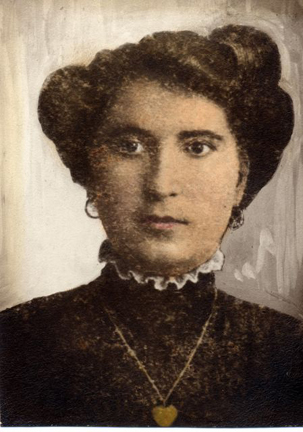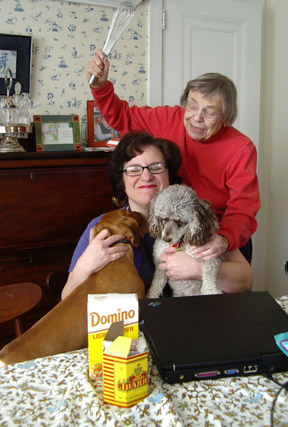
The kitchen at the Blue Heron Restaurant in Sunderland, Massachusetts, is a very busy place and a very happy one. Music plays as several cooks work in different sections of the room, creating tantalizing smells as they toast spices, glaze cakes, or efficiently peel and combine potatoes and parsnips. I spent a couple of hours there recently with Chef Deborah Snow—and I couldn’t help smiling almost continuously.
Deborah spent our time showing me how to make a dish that reflected her signature focus on local food. She took advantage of the fall harvest to make butternut-squash ravioli, a deceptively simple Tuscan dish that is a favorite with Blue Heron customers. “I’ve gotten a lot of marriage proposals with this,” she said of the ravioli. She served it with a devastatingly rich brown-butter sauce.
By using premade dumpling wrappers for the ravioli Deborah rendered them simple for home cooks. I helped her assemble the ravioli (when put together they look a bit like fried eggs) and was impressed at how easy they were to create.
The biggest trick in the recipe is the butter sauce, which can be a little temperamental; the butter should look brown and taste toasted but not burned. The other trick for the home cook will be timing. Deborah made the brown-butter sauce and the ravioli more or less simultaneously because she knows instinctively when to check on each pot.
Less experienced cooks should probably shape the ravioli and then begin browning the butter in order to keep a careful eye on the sauce. The ravioli can easily be boiled after the sauce is complete; these little pieces of pasta don’t take very long to cook.
I followed this method at home. My dish was almost as delicious as Deborah’s—if a bit less beautiful.
To learn more about the Blue Heron, visit its web site, http://www.blueherondining.com. Meanwhile, here is the recipe for the ravioli, kindness of Deborah Snow.
Blue Heron Butternut Squash Ravioli
Ingredients:
for the ravioli:
1 medium butternut squash
extra-virgin olive oil, kosher salt, and pepper to taste for roasting
1 cup shredded or grated Parmegiano-Reggiano cheese
1/4 cup extra-virgin olive oil
1/2 whole nutmeg, freshly grated
kosher salt to taste (start with 1 teaspoon)
freshly ground pepper to taste (start with 1/2 teaspoon)
72 round 3-inch wheat dumpling wrappers (available from Asian markets)
1 egg
additional cheese and several small sage leaves for garnish
for the sauce:
1 pound unsalted butter
10 fresh sage leaves, plus 5 more leaves later, chopped
1-1/4 cups white wine
1-1/2 cups heavy cream
Instructions:
for the ravioli:
Preheat the oven to 375 degrees. Cut the squash in half lengthwise, remove the seeds and gunk, and rub a little oil, salt, and pepper on the flesh. Roast the squash until it is soft enough to scoop out easily. Begin roasting with the flesh side down in your pan, and turn the squash over after about 20 minutes. Snow explains that the length of time it will take to roast the squash to the desired consistency depends on the strength of your oven. I would start checking the squash to see whether it is tender after about 30 minutes. It can take much longer than this, however, especially with young squash!
Scoop the squash out of its skin, and use a potato masher to blend in the cheese, olive oil, nutmeg, salt and pepper. (Do NOT use a food processor.)
Place half of the dumpling wrappers (36) on a work surface. Spoon a generous tablespoon of the squash mixture into the middle of each wrapper. You will probably have leftover squash, which is delicious by itself as a side dish.
Beat the egg with a splash of water; then use a pastry brush to brush the edges of the dumpling wrappers with the egg mixture. Place another wrapper on top, and use your fingertips to seal the edges of your ravioli, trying to push out any air bubbles that have formed.
Put a large pot of water (at least 2 quarts) on the stove, and add 2 teaspoons of salt. When the water comes to a boil, place the ravioli gently in the boiling water. Return the water to the boil, and cook for 3 to 4 minutes longer, stirring gently (particularly in the beginning) to keep the ravioli separated. Remove the ravioli gently from the water with a slotted spoon, place them in 6 individual pasta dishes, and ladle brown-butter sauce over all. Top with additional cheese and sage leaves. Serves 6 with 6 ravioli apiece.
for the sauce:
Place the entire pound of butter in a medium saucepan over medium heat, and bring it to a boil. Cook it slowly, monitoring its progress to keep it from burning. When it begins to turn brown around the edges, it is almost finished cooking. Skim off (and discard) any fuzz on top. The cooking process for the butter takes about 10 minutes on Deborah Snow’s very hot stove; it will probably take longer on a home range.
The butter will soon develop a rich caramel color. Turn off the heat, and add the first 10 chopped sage leaves. The butter will bubble up in response. Let it rest for a couple of minutes.
When the butter has cooled a bit, spoon out the milk solids and discard them; you will only need the liquid.
In a medium skillet, heat the wine until it is reduced by half. Whisk in the cream, and again let the liquid reduce by half. Throw in the additional chopped sage leaves while the sauce is reducing. When the sauce is nice and thick, whisk in the brown butter to taste. You may not need all of it, but you will need most of it.

















